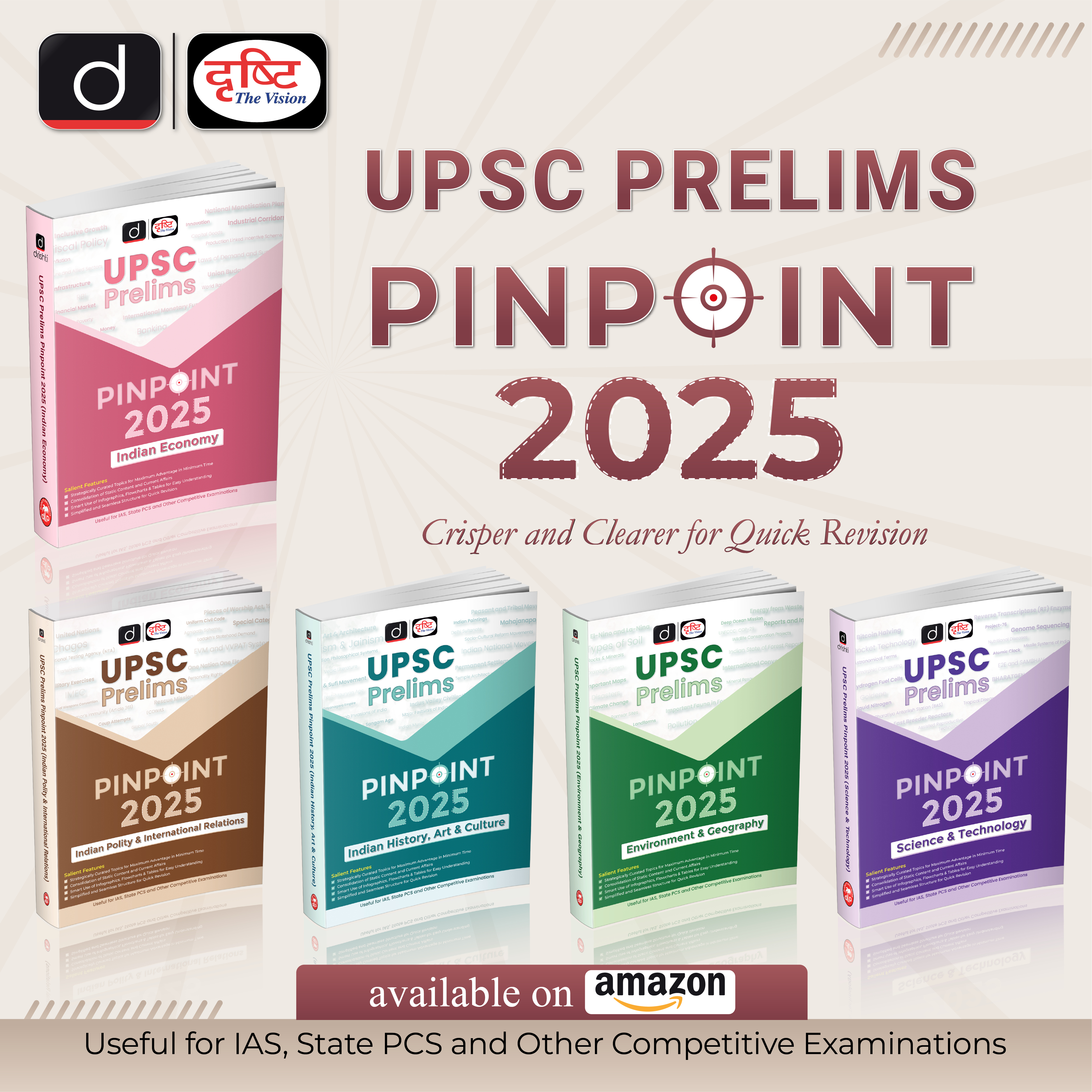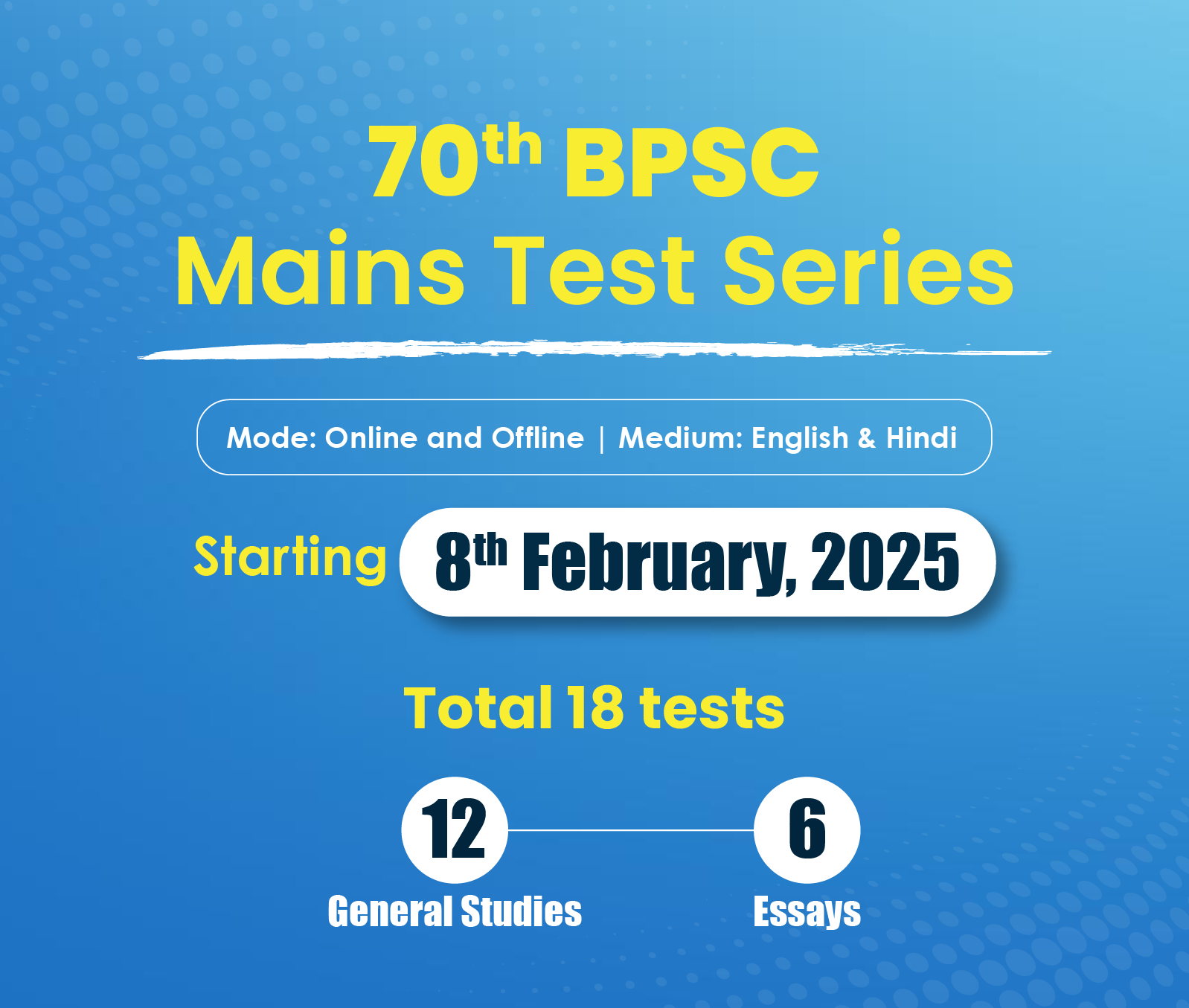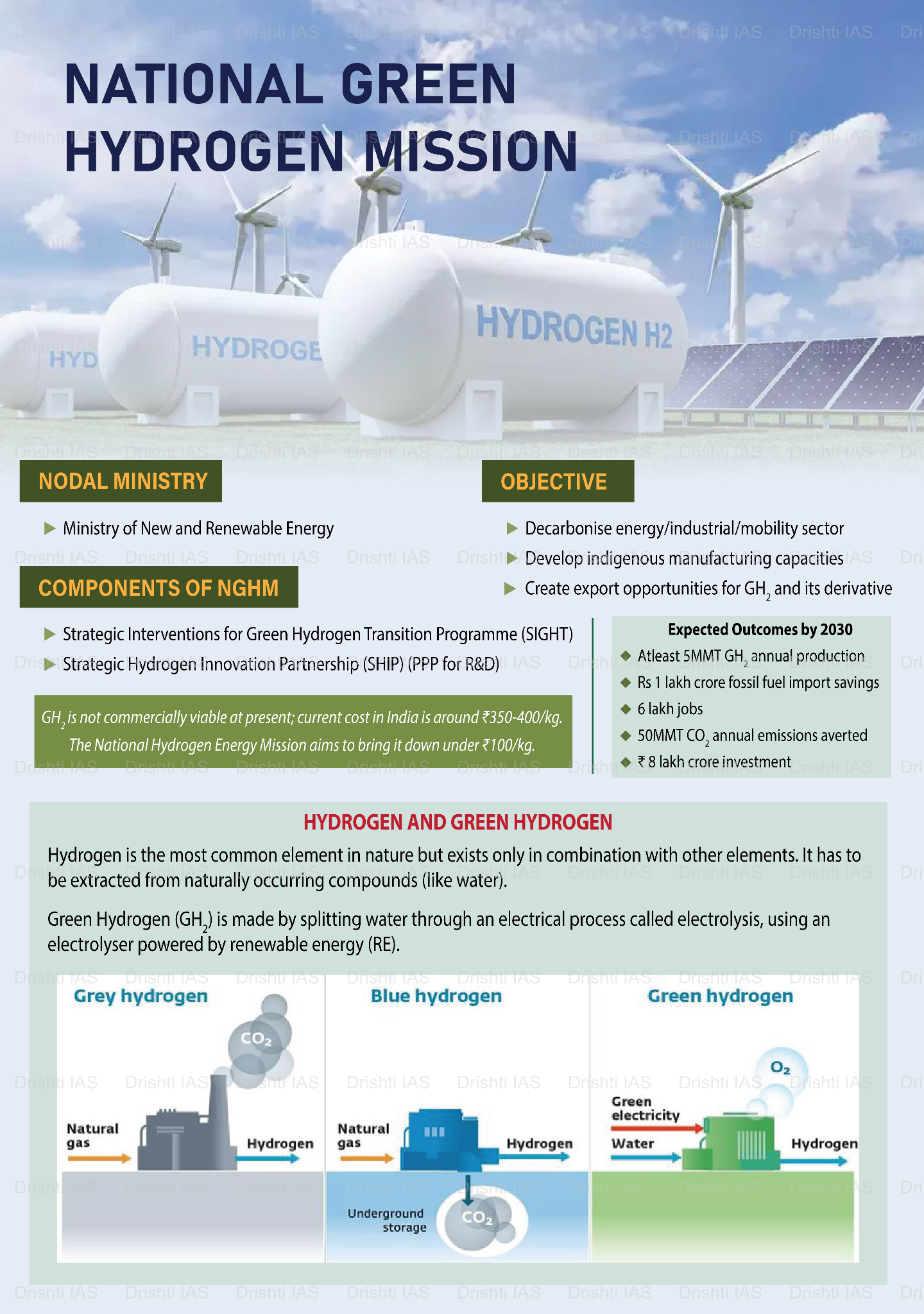Uttar Pradesh Switch to Hindi
Subsidies for Green Hydrogen Projects
Why in News?
Recently, the Uttar Pradesh cabinet approved its five-year Green Hydrogen Policy, earmarking 50.4 billion rupees (USD 608 million) for a subsidy programme to incentivise enough capacity for the 2028 target.
Key Points
- If successful, the policy would make up one fifth of India’s target of reaching five million tonnes of annual production by 2030, under its National Green Hydrogen Mission.
- This policy will target existing demand mostly in industrial processes such as chemicals and oil refining to replace grey hydrogen made using unabated fossil fuels.
- So far, hydrogen production technology has relied on gas, known as grey hydrogen. A significant effort is now under way to transition from grey hydrogen to green hydrogen.
- The policy outlines an ambitious goal to produce one million metric tonnes of green hydrogen annually within the next four years, by 2028.
- Producers, who will be granted fast-track environmental permitting, will also be eligible for a full rebate on transmission charges associated with using the intrastate grid, as well as full exemption from electricity tax (for ten years) and stamp duty.
- Fast Track Permitting incorporates a set of sound environmental policies and procedures that promote smart growth and economic development across the Commonwealth.
- The State government is also proposing to lease land for a single rupee per acre per year to state-owned enterprises setting up green hydrogen projects in the state.
- Private renewable Hydrogen investors will be eligible for a land lease rate of 15,000 rupees (USD 181) per acre per year.
Hydrogen
- Hydrogen is one of the most abundant elements on earth for a cleaner alternative fuel option.
- Type of hydrogen depend up on the process of its formation:
- Green hydrogen is produced by electrolysis of water using renewable energy (like Solar, Wind) and has a lower carbon footprint.
- Electricity splits water into hydrogen and oxygen.
- By Products: Water, Water Vapor.
- Brown hydrogen is produced using coal where the emissions are released to the air.
- Grey hydrogen is produced from natural gas where the associated emissions are released to the air.
- Blue hydrogen is produced from natural gas, where the emissions are captured using carbon capture and storage.
- Green hydrogen is produced by electrolysis of water using renewable energy (like Solar, Wind) and has a lower carbon footprint.
- Type of hydrogen depend up on the process of its formation:
- Uses:
- Hydrogen is an energy carrier, not an energy source and can deliver or store a tremendous amount of energy.
- It can be used in fuel cells to generate electricity, or power and heat.
- Today, hydrogen is most commonly used in petroleum refining and fertilizer production, while transportation and utilities are emerging markets.
- Hydrogen and fuel cells can provide energy for use in diverse applications, including distributed or combined-heat-and-power; backup power; systems for storing and enabling renewable energy; portable power etc.
- Due to their high efficiency and zero-or near zero-emissions operation, hydrogen and fuel cells have the potential to reduce greenhouse gas emission in many applications.
Uttar Pradesh Switch to Hindi
Uttar Pradesh Provides Skill Training Under Project Praveen
Why in News?
The Uttar Pradesh government has provided skill training to over 61,000 boys and girls in the state through 'Project Praveen'.
Key Points
- Under this scheme, youths are being provided free skill training and new-age courses to get prepared for the job market.
- This project is meant for students in classes 9 to 12, studying in higher secondary schools in the state.
- Students are receiving daily free training alongside their regular studies in trades aligned with their interests, such as the IT sector, electronics, beauty, healthcare, apparel, and accounting.
- 'Project Praveen' is being operated under a Memorandum of Understanding (MoU) between Secondary Education and the Uttar Pradesh Skill Development Mission.
- The primary objective of this project is to revamp the education system and curriculum of the state.
- Project Praveen was initiated as a pilot project in 2022-23.
- During this period, 20,582 students received training across 150 government secondary schools. Besides, Kasturba Gandhi Girls School was also linked to this scheme, facilitating training for 3,450 girl students.
- For the year 2023-24, a total of 315 government secondary schools have been included under the Project.
- So far, skill development training has been provided to 61,400 students through these institutes.
- All courses offered are certified and approved at the all-India level by the National Council for Vocational Education and Training.
- Upon completion of training and assessment, students are awarded certificates that hold validity throughout the country.
- Students undergoing training under Project Praveen are given training by private training centres in the school itself.
- These trainers are certified under the Training of Teachers (TOT) program and registered under the Skill Development Mission.
Uttar Pradesh Skill Development Mission (UPSDM)
- The UP Skill Development Mission was established as a society registered under the Societies Registration Act, 1860, under the Department of Vocational Education and Skill Development, Government of UP on 13th September, 2013.
- A National Skill Development Policy was launched in 2009 with the aim of skilling 500 million persons by 2022. Under the National Plan, the State of Uttar Pradesh aims to skill over 4 million youth by the end of the 12th Five Year Plan.
- In order to achieve this target and provide employable skills to the youth of the State, the UPSDM has been instituted.
- It is mandated to coordinate all skill development initiatives, leveraging on State Skill Development Policy.
- It empanelled Private Training Partners in addition to Government Training Partners for conducting skill development training.
National Council for Vocational Education and Training (NCVET)
- NCVET was established as a regulatory body by the Government of India on 5th December 2018. It has been fully operational since 1st August 2020.
- It serves as an overarching national regulator with the aim of setting standards, developing comprehensive regulations, and improving the vocational education, training, and skilling ecosystem.
- The primary objective of NCVET is to ensure strong industry interfacing and implement effective regulations that enhance the quality and outcomes of vocational education and training.
The National Skill Development Mission (NSDM)
- It aims to create convergence across sectors and States in terms of skill training activities.
- It also aims to expedite decision making across sectors to achieve skilling at scale with speed and standards.
Rajasthan Switch to Hindi
500 Electric Buses to be Introduced in Seven Rajasthan Cities
Why in News?
According to the sources, 500 electric buses will be introduced shortly for public transport in seven cities of Rajasthan, with an emphasis on reducing air pollution, creating convenience for commuters, and reducing fuel consumption.
Key Points
- The buses will be operated and maintained by the Local Self Government Department through Convergence Energy Services Limited.
- The buses would ply in Jaipur, Jodhpur, Kota, Ajmer, Bikaner, Bharatpur, and Udaipur.
- The maximum number of 300 buses will be operated in Jaipur, followed by 70 in Jodhpur.
- The promotion of public transport through electric buses would strengthen the network in the cities and improve the standard of urban life.
- The budgetary announcement would be implemented through the initiative for the benefit of the public at large.
Convergence Energy Services Limited
- Convergence is a green energy focused venture of the Energy Efficiency Services Ltd (EESL) Group owned by central public sector undertakings under the Ministry of Power, New and Renewable Energy.
- It offers interventions that solve multiple gap areas in the energy ecosystem by amalgamating seemingly independent sectors such as electricity, transport, home appliances and introducing models for adaptation at scale through government partnerships and innovative financing such as carbon markets.
Energy Efficiency Services Ltd
- It is a joint venture of National Thermal Power Corporation Limited (NTPC) Limited, Power Finance Corporation, Rural Electrification Corporation and POWERGRID, It was set up under the Ministry of Power to facilitate implementation of energy efficiency projects.
- EESL is a Super Energy Service Company (ESCO) that seeks to unlock the energy efficiency market in India, estimated at Rs. 74,000 crore that can potentially result in energy savings of up to 20% of current consumption, by way of innovative business and implementation models.
- It also acts as the resource centre for capacity building of State DISCOMs, financial institutions, etc.
Rajasthan Switch to Hindi
ESIC to Establish Sub-Regional Office in Rajasthan
Why in News?
Recently in the 231st Meeting of the Standing Committee of the Employees’ State Insurance Corporation (ESIC), a decision was taken to establish a Sub-Regional Office at Alwar, Rajasthan.
Key Points
- Around 12 Lakh Insured Workers and beneficiaries of ESI Scheme residing in the districts of Alwar, Khairthal-Tijara, Kothputilli-Behror, Bharatpur and Deeg will be benefited with establishment of a new ESIC Sub-Regional Office at Alwar.
- At total estimated cost of Rs.1128.21 crore is approved for the construction of 7 new ESI Hospitals at Harohalli, Narsapura, Bommasandra (Karnataka), Meerut, Bareilly (Uttar Pradesh), Pithampur (Madhya Pradesh) and Duburi (Odisha) was also accorded during the meeting.
Employees’ State Insurance Corporation
- Employees’ state Insurance Corporation of India is a multidimensional social system which provides socio-economic protection to the worker population and immediate dependent or family covered under the Employees' State Insurance Scheme (ESI) scheme.
- The ESI is an integrated measure of social Insurance embodied in the Employees' State Insurance Act, 1948.
- ESI is designed to accomplish the task of protecting employees against the impact of incidences of sickness, maternity, disablement and death due to employment injury and to provide medical care to insured persons and their families.
- Coverage of the Scheme:
- The ESI Scheme applies to factories and other establishment's viz. Road Transport, Hotels, Restaurants, Cinemas, Newspaper, Shops, and Educational/Medical Institutions wherein 10 or more persons are employed.
- However, in some States the threshold limit for coverage of establishments is still 20.
- Employees of the aforesaid categories of factories and establishments, drawing wages upto Rs. 15,000/- a month, are entitled to social security cover under the ESI Act.
- However, ESI Corporation has also decided to enhance the wage ceiling for coverage of employees under the ESI Act from Rs. 15,000/- to Rs. 21,000/-.
- ESI Corporation has extended the benefits of the ESI Scheme to the workers deployed on the construction sites located in the implemented areas under ESI Scheme from 1st August, 2015.
- The ESI Scheme is implemented district wise.
- It is now notified in 526 Districts in 34 States and Union Territories.
- The ESI Scheme applies to factories and other establishment's viz. Road Transport, Hotels, Restaurants, Cinemas, Newspaper, Shops, and Educational/Medical Institutions wherein 10 or more persons are employed.
Bihar Switch to Hindi
PM Unveils Projects in Bihar
Why in News?
Recently, the Prime Minister unveiled projects worth Rs 12,800 crore in Bihar's West Champaran district.
Key Points
- The PM unveiled the projects at a function, ‘Viksit Bharat-Viksit Bihar', in Bettiah, the district headquarters of West Champaran.
- He laid the foundation stone and dedicated to the nation:
- Multiple infrastructure projects related to rail, road, petroleum and natural gas.
- The city gas distribution project in East and West Champaran, Gopalganj, Siwan and Deoria, and grain-based ethanol facilities at Sugauli and Lauriya.
- The construction of a six-lane cable bridge on the Ganga river, parallel to the Digha-Sonepur rail-cum-road bridge at Patna, and four-laning of Bakarpur Hat-Manikpur section of NH-19 bypass.
- The doubling and electrification of the 96-km-long Gorakhpur CanttValmiki Nagar rail line and the redevelopment of Bettiah station.
- He inaugurated:
- The two-laning of the Piprakothi-Motihari-Raxaul section of the National Highway-28A and the two-laning of the Sheohar-Sitamarhi section of NH-104.
- A 109-km-long Indian Oil's Muzaffarpur-Motihari LPG pipeline that will provide access to cleaner cooking fuel in the state and also in Nepal.
- Indian Oil's LPG bottling plant and storage terminal at Motihari.
- The 62-km line from Bapudham Motihari to Piprahan and the gauge conversion of the Narkatiaganj-Gaunaha section.
- He flagged off two trains in the Narkatiaganj-Gaunaha and Raxaul-Jogbani sections.
Madhya Pradesh Switch to Hindi
Madhya Pradesh Ratlam's Riyawan Garlic Receives GI Tag
Why in News?
Recently, the flavourful garlic from Riyawan village in Jaora tehsil of Ratlam district has been awarded the Geographical Indication (GI) tag.
Key Points
- The GI registration process for Riyawan Garlic was initiated in January 2022 by the Farmer Producer Organisation (FPO) Riyawan Farm Fresh Producer Company in Chennai.
- Riyawan Garlic is renowned for its unique quality and high yield, with each bulb containing five to six cloves. Known for its pungent and robust flavour, this garlic variety also boasts a higher oil content compared to others.
- The GI tag opens up new opportunities in international markets, complementing the state government's efforts to promote Ratlam's garlic as a district product.
- The garlic variety is already in high demand within the country under the name RiyaWan Silver Garlic.
- For two decades, garlic has been cultivated using traditional methods in Riyawan village of Piploda tehsil.
- Riyawan has earned a reputation as the pioneer village for seed development, due to its unique qualities such as white curtain, bud size, and medicinal value. Its high storage capacity allows for long-term preservation.
Geographical Indication (GI) Tag
- A GI tag is a name or sign used on certain products that correspond to a specific geographical location or origin.
- The GI tag ensures that only the authorised users or those residing in the geographical territory are allowed to use the popular product name.
- It also protects the product from being copied or imitated by others.
- A registered GI is valid for 10 years.
- GI registration is overseen by the Department for Promotion of Industry and Internal Trade under the Ministry of Commerce and Industry.
- Legal Framework and Obligations:
- The Geographical Indications of Goods (Registration and Protection) Act, 1999 seeks to provide for the registration and better protection of geographical indications relating to goods in India.
- It is governed and directed by the WTO Agreement on Trade-Related Aspects of Intellectual Property Rights (TRIPS).
- Furthermore, the significance of protecting industrial property and geographical indications as integral components of intellectual property is acknowledged and emphasised in Articles 1(2) and 10 of the Paris Convention.








%20MPPCS%202025%20Desktop%20E.jpg)
%20MPPCS%202025%20Mobile%20E%20(1).jpg)










.png)
.png)











 PCS Parikshan
PCS Parikshan


